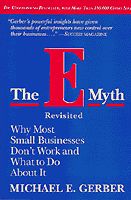 |
| ||||||||||||||||
 |
The E-Myth Revisited : Why Most Small Businesses Don't Work and What to Do About ItMichael E. Gerber
Excerpt from The Project 50 (Reinventing Work): Fifty Ways to Transform Every "Task" into a Project That Matters STEP NO. 1 TO WOW PROJECT POWER: AWARENESS! The NubSo, too, great project reframers! The good news: Curiosity can (more or less) be trained/learned. My best friend — my wife, actually — is one of a number of "notebook freaks" I know. When she's on a product-sourcing trip for her home-furnishings business, for instance, she'll fill 40 pages of a notebook (she copied this habit from her adored grandfather). There will be notes . . . and sketches . . . and pasted-in articles and ads from newspapers or magazines. Likewise, my friend and business guru Karl Weick carries a packet of 3 x 5-inch cards in his inside sport coat pocket: I've never seen him go more than 20 minutes — literally! — without jotting down some observation or other. Another pal writes on matchbook covers, cocktail napkins — and stuffs the little scraps into his left (always left!) pocket; he cleans out the pocket, he reports, every few days . . . and types the notes, with some elaboration, into an ongoing computer file. It boils down to studenthood-in-perpetuity/curiosity-in-perpetuity/applied-fanatic restlessness. That is, a belief that life is . . . ONE BIG LEARNING EXPERIENCE. Something mysterious happens to a curious, fully engaged mind — and it happens, as often as not, subconsciously. Strange little sparks are set off, connections made, insights triggered. The result: an exponentially increased ability to tune up/reinvent/WOW-ize today's project at work! Curiosity Capers Milliken and Co. chairman Roger Milliken: On the job for 50 years, he sits through a meeting, listening like a submarine commander. Meeting ends. Five minutes later, I observe Roger pacing in the parking lot, dictating machine in hand, noting his observations — and almost immediately translating these into "things to do." * * * Yours truly: I take a mass of notes — perhaps 20 pages — while listening to a two-hour presentation. In the next half hour I religiously retreat for a couple of minutes (literally) and distill these into summary points on a single 5 x 7-inch index card. * * * Jennifer Hansen, Hansen Design: "To keep myself focused at the beginning of a project, I start a small journal specifically for that job. . . . I jot my ideas for [that] project, whether a few words or a simple sketch, in [that] journal. I also tape and staple a lot of . . . article clippings and photocopies. . . . I also use these journals to keep notes from client phone calls and meetings. I keep this record with me until the close of the project — it's a great reference tool." Journal Power! From Aha!, by Jordan Ayan: "Creative thinkers ranging from the inventors Thomas Edison, Benjamin Franklin, and Leonardo da Vinci to the novelist Virginia Woolf, the psychologist Carl Jung, and the naturalist Charles Darwin all have used journals and notebooks to record their ideas and inspirations. These people understood that new ideas often come from combining many disparate pieces of information or concepts over an extended period of time. The only effective way to track your ideas and synthesize them is to document them as soon as they bubble up in your mind. . . . Tom Comment: Strong . . . and important . . . stuff! Put this book down. Right now.(But please pick it up again later!) Go out and buy yourself a journal — or start on the nearest scrap of paper — and make your first observation. It could well be one of the most important steps of your entire career. (P.S. I'm not exaggerating!) T.T.D./Awareness 1. Buy a simple spiral-bound notebook. TODAY. Label the front cover "Cool." Label the back cover "Awful." START RECORDING. TODAY. 2. Wander the local mall . . . TODAY . . . for one hour. Write down 10 "cool" and 10 "awful" observations: great (and awful) service, signage, merchandise, food, restrooms, decor, music, whatever. 3. Record these observations on your computer. Translate four of them to your current project. 4. Work with one or two pals on this. Start an Observations Fanatics Team. Share your "data" . . . and translate your insights/observations to your project(s).
|
|||||||||||||||||||||
|
All prices subject to change and given in U.S. Dollars. |
All materials contained in http://www.LeadershipNow.com are protected by copyright and trademark laws and may not be used for any purpose whatsoever other than private, non-commercial viewing purposes. Derivative works and other unauthorized copying or use of stills, video footage, text or graphics is expressly prohibited. LeadershipNow is a trademark of M2 Communications, LLC. |
